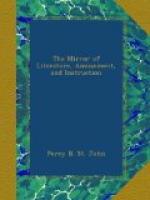So much for the fable. As to the word Hogue, there are several places in Jersey called Hougues, which are always situated on a rising ground. The word has evidently originated from the German hoch, from which is derived our English high. A hougue, therefore, means a mound or hillock, and in the present instance, the addition of bye is obviously a contraction of Hambye; and, in accordance with the foregoing tradition, means literally the barrow or tomb of the Seigneur de Hambye.
The chapel at la Hogue is said to have been rebuilt in imitation of the Holy Sepulchre at Jerusalem, by one of the popish deans of Jersey, in the reign of Henry VIII. La Hogue-bye remained for many years in a dilapidated state, till about 1790, when the late Admiral d’Auvergne, a native of Jersey, better known under his French title of Duke of Bouillon, became its owner by purchase, and hence it obtained its present name. At his death, in 1816, it was purchased by the late lieutenant-governor, Lieutenant-General Sir Hugh Mackay Gordon, whose heirs afterwards sold it to Francis le Breton, Esq., to whom it now belongs.
The most prominent object in the noble panoramic view from the top of Prince’s Tower, is a huge fortress on the eastern side of the island, called the Castle of Mont Orgueil. It crests a lofty conical rock, that forms the northern headland of Grouville Bay, and looks down, like a grim giant, on the subjacent strait. The fortifications encircle the cone in picturesque tiers, and the apex of the mountain shoots up in the centre of them, as high as the flag-staff, which is in fact planted upon it. During war a strong garrison constantly occupied Mont Orgueil, but now a corporal and two privates of artillery composed the whole military force. The corporal, a quiet intelligent man, who spoke with much horror of paying a visit to the West Indies, which, in the mutations of his professional life, he had a prospect of doing




